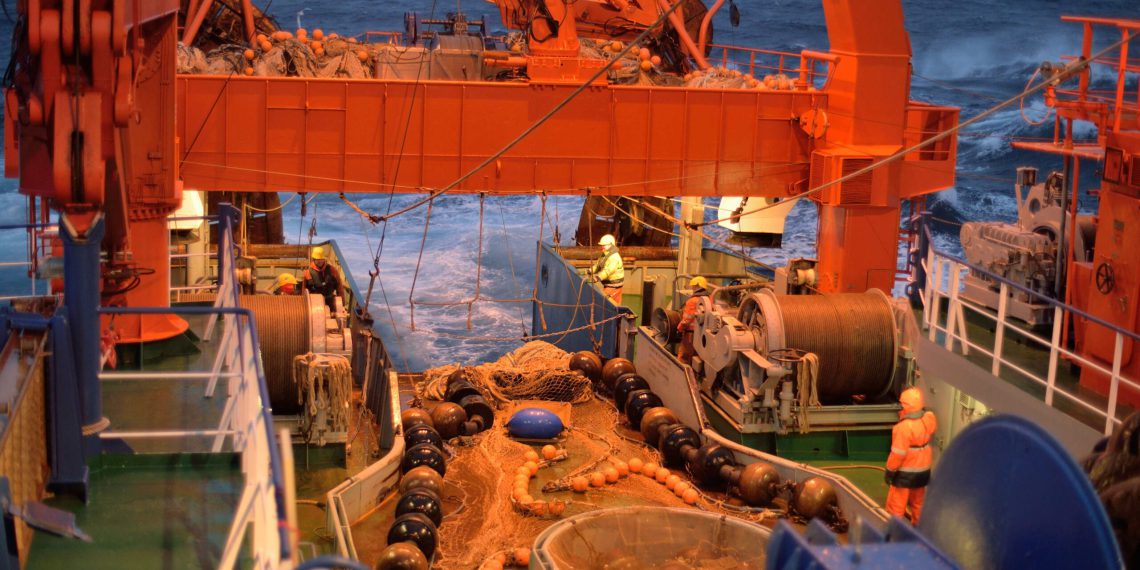Led by Dr. Karl-Michael Werner of the Thünen Institute of Sea Fisheries and Margrete Emblemsvåg of the Møreforsking AS Institute and the Arctic University of Norway, an international research team has discovered an unusual link between bottomfish communities in East Greenland and the effects of climate change. Evaluating long time series, they observed that ecosystems across the entire depth range of 150 to1500 meters of water depth responded simultaneously to changes in the atmosphere, sea ice cover, and surface temperature — surprisingly, most clearly in deep-sea fishes living below 400 meters of water depth.
Over nearly 20 years, from 1998–2016, researchers from the Thünen Institute of Sea Fisheries in Bremerhaven and the Greenland Institute of Natural Resources in Nuuk collected data on changes in the fish community at depths from 150 to 1500 meters. During this period, they sailed research vessels to similar locations off East Greenland each year to take samples with a scientific bottom trawl. This brought together information from nearly 1400 net catches.
“As we analyzed the fish abundance data, we realized that the changes in depth regions between 350 and 1000 meters were greater than the changes in shallower regions. When it was also statistically confirmed that these observations at depth correlated with changes in the atmosphere, the biggest challenge was to develop hypotheses about how these things were related.”
- Margrete Emblemsvåg
Ecological changes at depth
For their data analysis, the scientists used the statistical evaluation method “tensor decomposition,” which allowed them to examine spatial and temporal changes in fish communities simultaneously. “This method has not been used for ecological questions for long, but it was recently recognized that it is very well suited for analyzing spatiotemporal processes in fish communities,” explains Karl-Michael Werner of the Thünen Institute. “The most striking result was that the changes occurred at much greater depths than expected.” For example, even at depths of more than 400 meters, the researchers observed an increase in boreal species, i.e. species more adapted to warmth, such as tusk (Brosme brosme) and blue ling (Molva dypterygia), while the occurrence of Arctic and sub-Arctic species such as Greenland halibut (Reinhardtius hippoglossoides) and blue wolffish (Anarhichas denticulatus) decreased.
Slow change and extreme events
Tensor decomposition results showed that the distribution of fish communities at greater depths changed rapidly between the years 2005 and 2010. At the same time, both air temperature and surface layer salinity increased and sea ice extent decreased. However, the results also showed short-term changes in deep-sea fish communities in parallel with extreme environmental events, such as in 2003 when air temperature was exceptionally high. Fish communities in the deep sea thus appear to be sensitive to both slow changes and extreme events that lead to changes in ecological conditions within a very short time.
An elevator to the deep?
Since statistical analyses clearly demonstrate that bottom fish distributions are related to changes in the atmosphere and surface, it stands to reason that these physical changes create a biological cascade that extends from the surface to the deep sea. Something similar was observedhttps://www.industry24h.com/ at the same time in other areas of the North Atlantic. “Changes at the surface can affect sinking rates of organic material, including dying plankton, to the deep within weeks and months. This sinking biomass is an important food base for the seafloor species community on which fish feed,” explains Karl-Michael Werner.
The second hypothesis as to why species on the continental slope showed greater changes than in the shallower water layers could be due to the distribution of different water bodies. An earlier study by author Margrete Emblemsvåg showed that deeper layers, where water masses of Atlantic origin dominate, warmed slowly over the study period, while this was not the case in Arctic water bodies in the shallows. This gradual increase in temperature at depth may be the clock for the fundamental changes in fish distributions, while the extreme events are more likely responsible for the temporal swings in fish fauna via short-term changes in seafloor food availability. Clarification of these questions is the subject of further investigation.

















